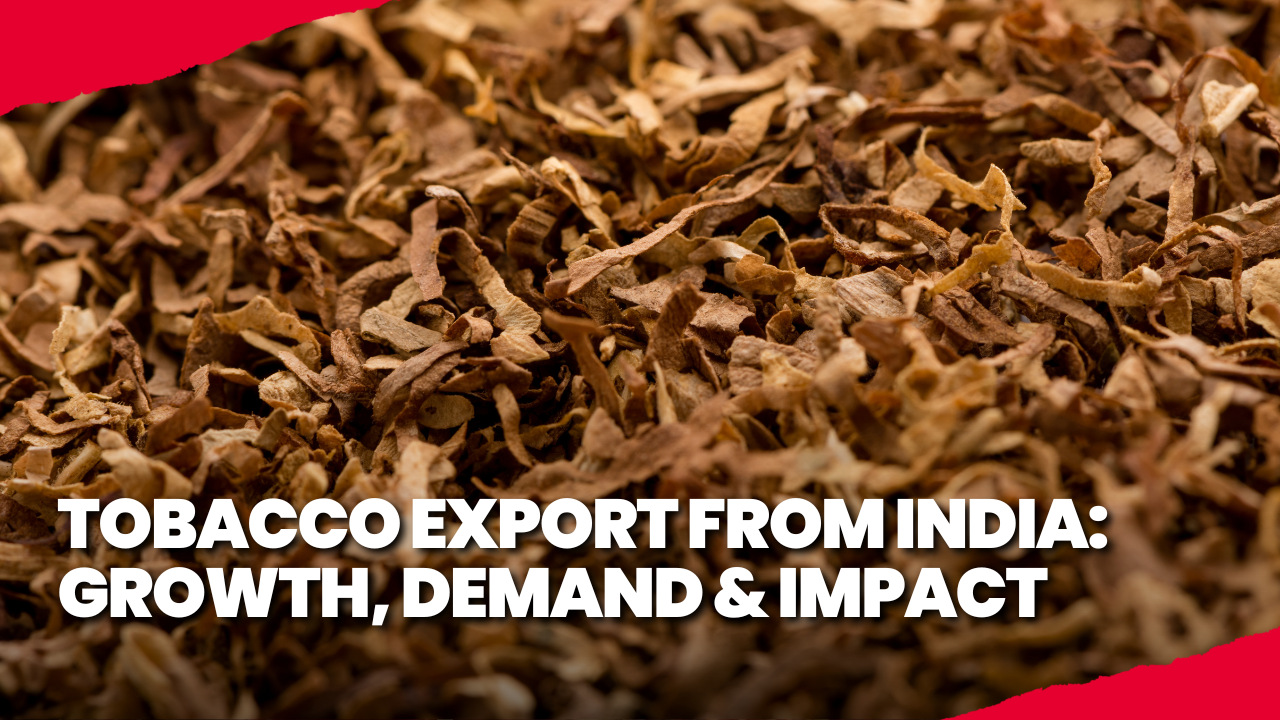
Consider a farmer in Andhra Pradesh who, many years ago, sold tobacco at local mandis for a modest profit. Now, her crop is part of a global supply system and is sent to places like Indonesia, the UAE, and Belgium. Tobacco export from India are more than just leaves; they’re a story of work, government policies, changing markets, and people’s ways of making a living.
As a result of its huge growth in recent years, India has become one of the biggest tobacco producers. However, problems lie beneath the surface, such as changing prices, strict rules about sustainability, and the urgent need to move up the value chain. Let’s look at the big picture, one farmer at a time, policy by policy, and export by export.
How Tobacco Export from India Has Grown Over the Years
India is transporting 315.5 million kilograms of tobacco in fiscal 2023–24, up from 218.8 million kilograms in fiscal 2019–20. This brought in about ₹12,006 crore (~$1.45 billion), 87% more in just five years.
Tobacco export from India is more unprocessed tobacco than any other country in the world (after Brazil), and it also grows the fourth most FCV (Flue-Cured Virginia) tobacco. About ₹7,552 crore of the total ₹12,00 crore came from FCV tobacco alone.
Where Indian Tobacco Reaches
- Belgium: 19% of exports, worth ₹2,350 crore
- UAE: 19%, or ₹2,300 crore
- Indonesia, the United States, Russia, Egypt, and Singapore are also big areas.
- India also sent 206.9 million kg ($883 million) worth of partially or fully stemmed tobacco abroad in 2023 and $20.6 million (30.36 million kg) of used tobacco.
Why farmers benefit and why they take the risk
About 45 million people in India work in tobacco farming, either directly or indirectly, through growing, processing, making, and exporting tobacco. FCV tobacco, in particular, has been a good crop to grow in semi-arid areas where not many other crops do well.
Farmers’ profits grew more than two times, from ₹124 per kg in 2019–20 to ₹279.5 per kg by 2023–24. This has helped people in the country make more money and move to cities less.
But things can get dangerous. Andhra Pradesh farmers grew 240 million kg of FCV tobacco in 2024–25, which was far more than the 167 million kg that was allowed. This caused the market to turn into a saturated market, prices to fall (₹220–₹250/kg), and farmer concerns to increase.
A lot of farmers thought they would get ₹300/kg, but they have had trouble selling extra stock for months.
To help farmers, AP Markfed is buying 80 million kg of black or high-yield Burley tobacco to control stock levels and support prices.
How Policies Are Helping Farmers and Growing Exports
The national government and the Tobacco Board have taken a number of steps to help because they know the risks and opportunities.
- MSME exporters can get discounted export credit at rates of 2 to 3 % through the Interest Equalization Scheme.
- With a drawback rate of 0.15%, the duty drawback scheme gives refunds on import duties for materials used in tobacco goods.
- Growers’ Welfare Scheme: A ₹25 crore fund helps FCV growers with other good causes.
- E-auctions and rating systems are getting better, so they can meet standards everywhere.
These steps were taken to keep prices stable in the country, ensure the quality of goods exported, and help farmers get back on their feet after market changes.
Also Read this: Gold Import Duty in India 2025: Price Drop, and Policy Changes
Focusing on Products with More Value
India gets a lot of its revenue from exports right now, mostly from raw tobacco (₹4–5/kg). However, nicotine extracts, cut tobacco (cut-rag), and tobacco-based bags sell for a lot more money.
Indian companies delivered out about 110,361 metric tons of FCV tobacco worth ₹4,524 crore (US$547 million) in 2023 alone.
The U.S., Brazil, and Zimbabwe are moving up the value chain. For example, Zimbabwe now uses about 30% of its imported tobacco, up from only 2% before.
Like other companies, some Indian companies are making nicotine pouches and snus-like goods for markets in Europe and West Asia. This change can help people make more money and depend less on the price of raw leaves.
Wrapping It Up
Tobacco export from India are making an international impact. Tobacco supports millions from Andhra Pradesh farms to Belgian and Indonesian purchasers.
The future requires better methods due to rising global standards, market oversupply, and environmental concerns. Investment in value-added tobacco products and proper farmer support would help India lead in quantity, quality, and innovation. Tobacco export from India will stay competitive for years if the current pace and greater planning and diversification continue.
FAQs
Belgium and the UAE import 19% of exports, followed by Indonesia, the US, and Russia.
Exports increased 87% in quantity and value between FY 2019–20 and 2023–24, indicating global demand for Indian tobacco.
The government offers export credit, duty drawback promotions, a ₹25 crore Growers’ Welfare Fund, and improved auction mechanisms to improve farmer income and price stability.
Also Checkout Our YouTube Channel: @limeinstituteofexportimport






